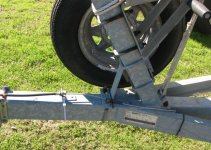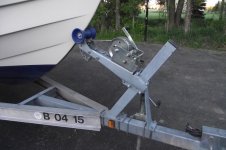Thanks for all of the interesting comments. I agree, I had questioned the size of the trailer--but that was what was sold with the boat. I would have considered it a Yard Trailer. However, we towed it 1200 miles home, and not problems, then over 7000 miles out west one summer. Another 2000 miles around FL, and the South--no problems.
Sorry to have missed you Nancy and Bob! Yes, I was concentrating on the road!
The bow was tight against the bow roller, so there was no flexing. of the boat. There is also a fairly tight SS chain, going to the winch stand right under the winch--so the bow could not move more than a couple of inches at the most. I don't think the bow was bouncing--I think the trailer was flexing.
Dave, your trailer seems to be a bit different, with using I beams, where a lot of trailers use square rails. But your rig actually looks a little less substantial than what I have, in the bow roller support--and photos are deceiving. Point well taken that the V or Y of the frame is further forward on the old trailer. On the new trailer the bow support is behind the V or Y where the side rales do meet the tongue--and your points are very valid.
Dave, the stress crack developed as the towing service was pulling the tongue up and down, to see how it would handle on the road-the conclusion was it would not well--and thus the slow speed and extra chains on the the frame.
Good idea to forward photos to Load Rite. As I recollect the trailer was rated for about 5000 lbs. I may have a photo of the plate in my collection. The insurance company has assigned an investigator to examine the trailer.
The trailer had surge brakes which worked well before the damage--when the brake line failed. The coupler was well locked on (with a lock thru the pin on the coupler)--and the tow guy said move the RV--and I said I cannot undo the coupler--and he could not either. It ooh some creative work to get the coupler loose. Yes, if the front had dug in it would have been interesting.
Many years ago (1961), I had a grossly overloaded trailer loose its axle, and the suspending arms dig into the hot tarmac on I 10 in New Mexico. It stopped the car like a Danforth anchor dug in--and we plowed up some of the pavement-the coupling held in that case also.
This trailer failure is the second I have had in the last 50 years.



